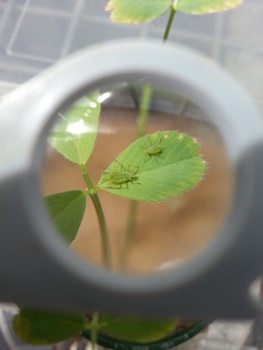Doctor James Ryalls
Candidature
 Graduated PhD 2016
Graduated PhD 2016
Thesis Title
The impacts of climate change and belowground herbivory on aphids via primary metabolites
Research Project
Lucerne or alfalfa Medicago sativa is the most important temperate forage legume worldwide. Only one or two varieties of lucerne, developed for their adaptive and resistant qualities, were present throughout Australia prior to the late 1970s. This date coincided with the arrival of invasive aphid species, devastating lucerne stands and prompting the development of aphid-resistant cultivars to control these aphid pests and improve crop security. The lucerne-feeding aphids include bluegreen aphids (Acyrthosiphon kondoi), pea aphids (Acyrthosiphon pisum), spotted alfalfa aphids (Therioaphis trifolii maculata) and cowpea aphids (Aphis craccivora), all presenting significant risks for the lucerne industry worldwide.
Many studies report on plant-mediated interactions between spatially-separated insect herbivores (above- and belowground), yet few studies have considered this interaction in the context of global climate change. Indeed, while the effects of predicted increases in atmospheric temperature and carbon dioxide concentrations on insect-plant interactions have been characterised separately, only a handful consider more than one climatic variable or multiple trophic groups. Incorporating trophic complexity and multiple climatic factors represents a significant challenge for biologists, yet one that we must start to address to gain realistic insights into how global climate change will affect insect-plant interactions.
Recent research at Hawkesbury has shown that aphid resistance in some lucerne cultivars can become compromised under predicted concentrations of atmospheric carbon dioxide. My PhD project builds on, and extends, this research to address how both climate and interactions with other herbivores might shape lucerne aphid populations in the future. In particular, I am investigating how the root-feeding lucerne weevil (Sitona discoideus) might make plants more susceptible to aphid attack aboveground. My project aims to address this using a series of field-, glasshouse- and laboratory-based approaches to investigate the impact of climate change on aboveground-belowground pest interactions in lucerne. My overall aim is to characterise how global climate change might affect these lucerne pests, both individually and interactively.
Research Image

Research Project Supervisors
Dr Scott Johnson, A/Professor Markus Riegler and Dr Ben Moore
Publications
Book Chapters
Johnson SN, Ryalls JMW, Staley JT. 2016. Impacts of climate and atmospheric change on aboveground–belowground invertebrate interactions. In: Johnson SN, Jones TH, eds. Invertebrates and Climate Change. Oxford, UK: Wiley, in Press.
Ryalls JMW, Harrington, R. 2016. Climate and atmospheric change impacts on aphids as vectors of plant diseases. In: Johnson SN, Jones TH, eds. Invertebrates and Climate Change. Oxford, UK: Wiley, in Press.
Journals
Johnson SN, Ryalls JMW, Barton CVM, Tjoelker MG, Wright IJ, Moore BD, (2019) 'Climate warming and plant biomechanical defences: Silicon addition contributes to herbivore suppression in a pasture grass', Functional Ecology, vol.33, no.4, pp 587-596
Johnson SN, Glauser G, Hiltpold I, Moore BD, Ryalls JMW, (2018) 'Root herbivore performance suppressed when feeding on a jasmonate-induced pasture grass', Ecological Entomology, vol.43, no.4, pp 547-550
Johnson SN, Lopaticki G, Aslam TJ, Barnett K, Frew A, Hartley SE, Hiltpold I, Nielsen UN, Ryalls JMW, (2018) 'Dryland management regimes alter forest habitats and understory arthropod communities', Annals of Applied Biology, vol.172, no.3, pp 282-294
Johnson SN, Ryalls JMW, Gherlenda AN, Frew A, Hartley SE, (2018) 'Benefits from Below: Silicon Supplementation Maintains Legume Productivity under Predicted Climate Change Scenarios', Frontiers in Plant Science, vol.9, Article no.202
Kremer JMM, Nooten SS, Cook JM, Ryalls JMW, Barton CVM, Johnson SN, (2018) 'Elevated atmospheric carbon dioxide concentrations promote ant tending of aphids', Journal of Animal Ecology, vol.87, no.5, pp 1475-1483
Ryalls JMW, Moore BD, Johnson SN, (2018) 'Silicon uptake by a pasture grass experiencing simulated grazing is greatest under elevated precipitation', BMC Ecology, vol.18, no.1, Article no.53
Ryalls JMW, Moore BD, Johnson SN, Connor M, Hiltpold I, (2018) 'Root responses to domestication, precipitation and silicification: weeping meadow grass simplifies and alters toughness', Plant and Soil, vol.427, no.s 1-2, pp 291-304, Special Issue: SI
Johnson SN, Hartley SE, Ryalls JMW, Frew A, DeGabriel JL, Duncan M, Gherlenda AN, (2017) 'Silicon-induced root nodulation and synthesis of essential amino acids in a legume is associated with higher herbivore abundance', Functional Ecology, vol.31, no.10, pp 1903-1909
Ryalls JMW, Moore BD, Riegler M, Bromfield LM, Hall AAG, Johnson SN, (2016) 'Climate and atmospheric change impacts on sap-feeding herbivores: a mechanistic explanation based on functional groups of primary metabolites', Functional Ecology, (in press)
Johnson SN, Gherlenda AN, Frew A, Ryalls JMW, (2016) 'The importance of testing multiple environmental factors in legume–insect research: Replication, reviewers, and rebuttal', Frontiers in Plant Science, vol.7, Article no.489
Ryalls JMW, Moore BD, Riegler M, Johnson SN, (2016) 'Above-belowground herbivore interactions in mixed plant communities are influenced by altered precipitation patterns', Frontiers in Plant Science, vol.7, Article no.345
Ryalls JMW, Moore BD, Riegler R, Gherlenda AN, Johnson SN, (2015) 'Amino acid-mediated impacts of elevated carbon dioxide and simulated root herbivory on aphids are neutralized by increased air temperatures' Journal of Experimental Botany, vol.66, no.2, pp 613-623
Johnson SN, Ryalls JMW, Karley AJ, (2014) 'Global climate change and crop resistance to aphids: contrasting responses of lucerne genotypes to elevated atmospheric carbon dioxide', Annals of Applied Biology, vol.165, no.1, pp 62-72
Ryalls JMW, Riegler M, Moore BD, Johnson SN, (2013) 'Biology and trophic interactions of lucerne aphids', Agricultural and Forest Entomology, vol.15, no.4, pp 335-350
Ryalls JM, Riegler M, Moore BD, Lopaticki G, Johnson SN, (2013) 'Effects of elevated temperature and CO2 on aboveground-belowground systems: a case study with plants, their mutualistic bacteria and root / shoot herbivores', Frontiers in Plant Science, vol.4, p 445